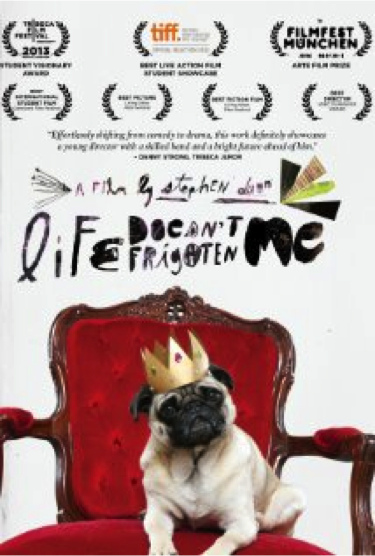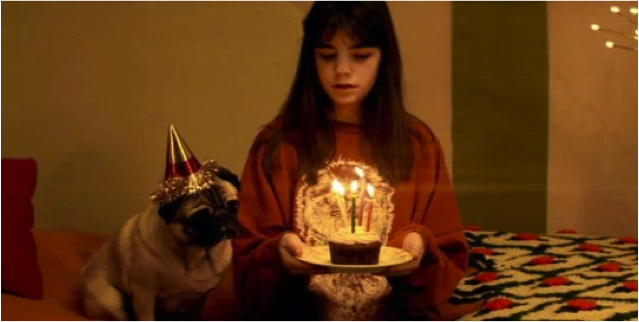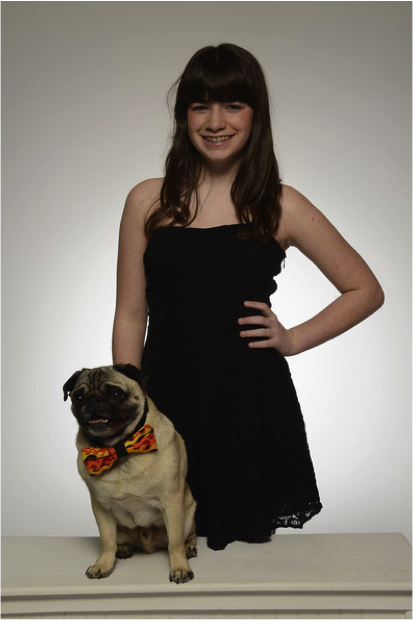Stephen Dunn’s 2012 Canadian short film, Life Doesn’t Frighten Me, presents viewers with a campy peek into the life of thirteen-year old Esther as she embarks upon her journey into womanhood. Taking place over the course of her thirteenth birthday, the film primarily revolves around Esther’s apprehensive feelings towards her imperfect appearance and her newly arrived monthly “gift.” Ultimately, this coming-of-age narrative compels viewers to empathize with Esther’s insecurities, pulling at the heartstrings of post-pubescent viewers who, in looking back upon their days as teenagers, can relate all-too-well to the angsty period of maturation in which Esther finds herself. Throughout the entirety of the twelve-minute film, Esther’s pet pug dog, King Henry, is her only real companion. In return, Esther provides great companionship for King Henry. In my essay, I will explore Esther and King Henry’s camaraderie, which is implied through aspects of the mise-en-scène, eye-line matches, character actions/expressions, and elements of non-diegetic sound throughout the short film.
To begin, aspects of the mise-en-scène in Dunn’s Life Doesn’t Frighten Me provide significant insight into the unique companionship shared by Esther and her pug dog. Throughout the entirety of the short film, Esther almost always appears to be in a state of perpetual retreat— whether she’s avoiding the scrutiny of her classmates or running from the concern of her sympathetic grandfather. However, upon reconvening with her pet pug as she returns home from school, we finally see Esther refrain from retreating and settle down comfortably in the company of her furry friend. Shutting herself in her bedroom, the closed door serves as a barrier between Esther and the harsh, unfavorable outside world. The fact that King Henry is the only character Esther chooses to allow into her temporary hiatus from reality is highly indicative of the two characters’ deep bond. Thus, it becomes evident that Esther’s unique camaraderie with her pug provides an affect that, for her, is not met by any other character in the film.
In addition to specific elements of the mise-en-scène, eye-line matches also exhibit a strong sense of companionship between Esther and her dog. For much of the film, Esther scrutinizes her appearance and expresses her dissatisfaction with it; however, during the scene in her bedroom, she finally focuses her attention outside herself as she plays with her adorable, lively pet pug. In this specific scene, we get an idea of Esther’s feelings of connectedness with the dog; a sequence of reverse shots creates a bond between the two characters through eye-line matches between the gazes of girl and dog. With each progressive eye-line match between the two characters, we become increasingly aware of the intimate connection they share. Whereas in other scenes Esther avoids making open eye contact with her peers, here we see her unabashedly submit to gazing into King Henry’s eyes. Likewise, we see the pug maintaining strong eye contact with his human friend. Thus, through the reverse shots/eye-line matches in this specific scene, we gather an even greater sense of Esther and her dog’s camaraderie— the only true companionship Esther seems to feel throughout the film.
Additionally, Esther’s other actions demonstrate her close companionship with the pug. Directly following the reverse shots that suggest that the two characters have locked eyes, Esther tapes up her nose in a way that directly resembles the up-turned nose of her furry friend. As she does this, clearly attempting to mirror the appearance of her pet, her face gives way to a joyous smile for the first time in the film. This smile embodies Esther’s comfort and happiness while in the presence of her dog; it is the only time Esther demonstrates such positive emotion in the entire film. Likewise, around the same time as Esther’s smile (9:19), King Henry displays a “smile” in return— a wide, open-mouthed expression, as similar to a human smile as a dog could possibly make. The exchange of these smiles only further strengthens the bond between the two characters. Thus, through these actions, Esther and King Henry possess a unique camaraderie that, for Esther, is not met by any other characters throughout the film.
Lastly, elements of the non-diegetic soundtrack are also indicative of the companionship between Esther and her pug dog. In the same scene in which Esther locks herself in her bedroom, all remains silent until the two characters start to interact. Directly prior to the moment in which Esther tapes up her nose, the silence gives way to a sweet and contemplative melody (composed for the film by renowned indie musician Sufjan Stevens) that mirrors Esther’s increasing ease and contentment in the presence of her friend (Dunn 1). Thus, the implementation of the soundtrack at this instance in the short film only further exemplifies the camaraderie shared between Esther and King Henry the pug dog— the only camaraderie Esther seems to experience throughout the entire film.
Conclusively, in Stephen Dunn’s 2012 Canadian short film, Life Doesn’t Frighten Me, the young, insecure character Esther discovers true companionship through her relationship with her pet pug dog. Through elements of the mise-en-scène, character actions (highlighted by eye-line matches and facial expressions), and the non-diegetic soundtrack, we gather a strong sense of this mutual friendship— the only source of friendship Esther experiences throughout the entirety of this quirky coming-of-age tale. Ultimately, King Henry’s camaraderie seems to give Esther the hope that she’ll be able to make it through the tangle of teenage trauma she finds herself momentarily caught up in— with a trusty friend by her side, anything is possible.
Bibliography
Dunn, Stephen. “CLICK HERE to Support LIFE DOESN’T FRIGHTEN ME.” Indiegogo. Indiegogo, Inc., n.d. Web. 04 Dec. 2015. https://www.indiegogo.com/projects/life-doesn-t-frighten-me#.
Life Doesn’t Frighten Me. Dir. Stephen Dunn. LDFM Films, 2012. Film.
Visuals Cited
Image 1: “Life Doesn’t Frighten Me.” IMDb. IMDb.com, n.d. Web. 09 Nov. 2015. http://www.imdb.com/title/tt2397501/.
Image 2: “BIFF 2013 #19: Life Doesn’t Frighten Me (Canada 2012).” The Case for Global Film. itpworld.wordpress.com, n.d. Web. 3 Dec. 2015. https://itpworld.wordpress.com/2013/04/19/biff-2013-19-life-doesnt-frighten-me-canada-2012.
Image 3: “Tribeca Film Festival Portrait Studio: Day 1.” Zimbio. Zimbio.com, n.d. Web. 3 Dec. 2015. http://www.zimbio.com/pictures/mwZFgYdYTIP/Tribeca+Film+Festival+Portrait+Studio+Day/2yINxWiLM3c/Jade+Aspros.
Works Referenced
“Stephen Dunn Director.” Stephen Dunn Director. N.p., n.d. Web. 03 Dec. 2015. http://www.stephendunn.ca.


